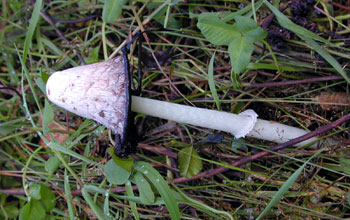Multimedia Gallery
Unknown species of mushroom from Southern Sakhalin Island, Russia
An unknown species of mushroom from Southern Sakhalin Island, Russia.
More about this Image
When the immune response is compromised, bacteria are able to colonize the tiny alveoli sacs of the lung and form biofilms. Biofilms do not trigger the neutrophils (white blood cells) to become activated, even in the presence of antibodies (yellow symbols). When biofilm cells are released from the community singly, they are readily recognized and ingested by neutrophils.
This is part of ongoing research at the Center for Biofilm Engineering at Montana State University, Bozeman, where multidisciplinary research teams find solutions and applications for industrially relevant problems and potentials of microbial biofilm formation.
What is Biofilm?
Biofilms are all around us, as plaque on your teeth, in your sink drain, coating rocks in rivers and streams. Biofilms form when bacteria adhere to surfaces in aqueous environments and begin to excrete a slimy, glue-like substance that can anchor them to all kinds of material such as metal, plastic, soil particles, medical implant materials and tissue. Although a biofilm can be formed by a single bacterial species, they usually consist of many species of bacteria, as well as fungi, algae, protozoa, debris and corrosion products. Once anchored to a surface, biofilm microorganisms carry out a variety of reactions, either detrimental or beneficial, depending on the surrounding environmental conditions.
Industry in the U.S. loses billions of dollars annually due to biofilm damage such as corroded pipes, reduced heat transfer or hydraulic pressure in industrial cooling systems, plugged water injection jets, and clogged water filters. Biofilms can also cause major medical problems by infecting host tissues, harboring bacteria that contaminate drinking water, and causing rejection of medical implants. Scientists and engineers at the CBE are developing promising solutions to these biofilm-related problems. (Year of image: 2004)
Credit: Photo by Trevor R. Anderson
See other images like this on your iPhone or iPad download NSF Science Zone on the Apple App Store.
Images and other media in the National Science Foundation Multimedia Gallery are available for use in print and electronic material by NSF employees, members of the media, university staff, teachers and the general public. All media in the gallery are intended for personal, educational and nonprofit/non-commercial use only.
Images credited to the National Science Foundation, a federal agency, are in the public domain. The images were created by employees of the United States Government as part of their official duties or prepared by contractors as "works for hire" for NSF. You may freely use NSF-credited images and, at your discretion, credit NSF with a "Courtesy: National Science Foundation" notation.
Additional information about general usage can be found in Conditions.
Also Available:
Download the high-resolution JPG version of the image. (1.3 MB)
Use your mouse to right-click (Mac users may need to Ctrl-click) the link above and choose the option that will save the file or target to your computer.

